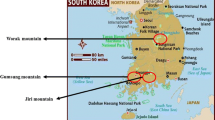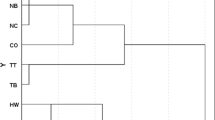Abstract
Senescent foliage from pines is potentially a large contributor to the total monoterpene content of the litter layer, and the availability of these compounds as phytotoxins may result from release of these compounds into the vapor phase. In order to determine the fate of several monoterpene hydrocarbons in the natural environment, we examined their concentrations in fresh, senescent, and decaying needles from 32 single-leaf pinyon pine (Pinus monophylla Torr. & Frem.: Pinaceae) trees growing at two different locations. Total monoterpene content was highest in the fresh needles (mean=5.6 ± 2.2 mg/g extracted air dry weight), but also remained relatively high in senescent needles (mean=3.6 ±1.8 mg/g extracted air dry weight), either still attached to the tree or forming the freshest layer of understory litter. Decaying needles within a dark decomposing layer of litter material 5–20 cm from the surface were found to contain much lower amounts of total monoterpenes (average: =0.12 ±0.06 mg/g extracted air dry weight). Further investigation of the fate of these compounds in the pinyon understory is required to determine if these hydrocarbons are indeed exerting phytotoxic characteristics.
Similar content being viewed by others
References
Bradow, J.M., andConnick, Jr., W.J. 1990. Volatile seed germination inhibitors from plant residues.J. Chem. Ecol. 16(3):645–666.
Elmore, C.D. 1985. Assessment of the allelopathic effects of weeds on field crops in the humid Midsouth, pp. 21–32,in A.C. Thompson (ed.). The Chemistry of Allelopathy. American Chemical Society Symposium Series No. 268. American Chemical Society, Washington, D.C.
Esau, K. 1965. Plant Anatomy, 2nd ed. John Wiley & Sons, New York.
Esau, K. 1977. Anatomy of Seed Plants, 2nd ed. John Wiley & Sons, New York.
Everett, R.L. 1987. Allelopathic effects of pinyon and juniper litter on emergence and growth of herbaceous species, pp. 62–67,in G.W. Frasier and R.A. Evans (eds.). Proceedings, Symposium on Seed and Seedbed Ecology of Rangeland Plants. USDA-ARS, Tucson, Arizona, 21–23 April 1987.
Fahn, A. 1970. Morphological and anatomical changes related to resin stimulation. The Hebrew University of Jerusalem, Jerusalem, Israel. USDA final report, Department of Botany Project A10-FS-15.
Fahn, A. 1979. Secretory Tissues in Plants. Academic Press, New York.
Gifford, E.M., andFoster, A.S. 1989. Morphology and Evolution of Vascular Plants, 3rd ed. W.H. Freeman, and Co., New York.
Groves, C.R., andAnderson, J.E. 1981. Allelopathic effects ofArtemisia tridentata leaves on germination and growth of two grass species.Am. Midl. Nat. 106:73–79.
Jameson, D.A. 1966. Pinyon-juniper litter reduces growth of blue grama.J. Range Manage. 19:214–217.
Mirov, N.T. 1967. The GenusPinus. The Ronald Press, New York.
Muller, C.H. 1968. Allelopathic control of herb growth in the fire cycle of California chaparral.Bull. Torrey Bot. Club 95:225–231.
Putnam, A.R. 1983. Allelopathic chemicals: Nature's herbicides in action.Chem. Eng. News 61(14):35–45.
Putnam, A.R. 1985. Allelopathic research in agriculture: past highlights and potential, pp. 1–8,In A.C. Thompson (ed.). The Chemistry of Allelopathy. American Chemical Society Symposium Series No. 268. American Chemical Society, Washington, D.C.
Rice, E.L. 1984. Allelopathy, 2nd ed. Academic Press, New York.
Soil Survey Staff 1975. Soil Taxonomy: A Basic System of Soil Classification for Making and Interpreting Soil Surveys. USDA-SCS Agric. Handb. 436. U.S. Government Printing Office, Washington, D.C.
Weast, R.C., Astle, M.J., andBeyer, W.H. 1986. Handbook of Chemistry and Physics. Chemical Rubber Co. Press, Boca Raton, Florida.
Whittaker, R.H., andFeeny, P.P. 1971. Allelochemics: chemical interactions between species.Science 171(3973):757–770.
Wilt, F.M., Miller, G.C., andEverett, R.L. 1988. Monoterpene concentrations in litter and soil of single-leaf pinyon woodlands of the western great basin.Great Basin Nat. 48(2):228–231.
Zavarin, E. 1968. Monoterpenoids of Cohiferales.L.A.W.A. Bull. 1:3–12.
Zavarin, E., andSnajberk, K. 1980. Oleoresins of pinyons.J. Agric. Food Chem. 28:829–834.
Zavarin, E., Snajberk, K., andCool, L. 1990. Chemical differentiation in relation to the morphology of the single-needle pinyons.Biochem. Syst. Ecol. 18:125–137.
Author information
Authors and Affiliations
Rights and permissions
About this article
Cite this article
Wilt, F.M., Miller, G.C., Everett, R.L. et al. Monoterpene concentrations in fresh, senescent, and decaying foliage of singleleaf pinyon (Pinus monophylla Torr. & Frem.: Pinaceae) from the western Great Basin. J Chem Ecol 19, 185–194 (1993). https://doi.org/10.1007/BF00993688
Received:
Accepted:
Issue Date:
DOI: https://doi.org/10.1007/BF00993688




